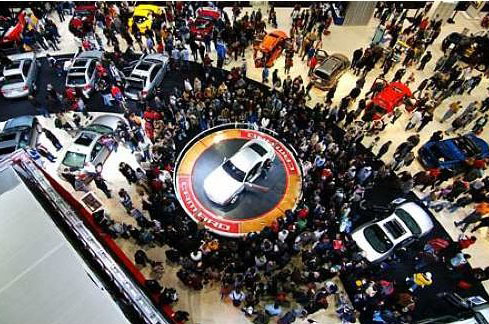50 million cars a year by 2021: DRC
 0 Comment(s)
0 Comment(s) Print
Print E-mail
China Daily, July 11, 2011
E-mail
China Daily, July 11, 2011
|
|
|
Vehicle production and sales in?China both surpassed 18 million units last year, a 38 percent increase over the 13 million sold in 2009. |
Despite a slowdown this year, the Chinese auto market may triple in size over the next 10 years, said a senior member of an influential government think tank.
"The Chinese auto industry is likely to reach a peak of 50 million units over the next decade," said Liu Shijin, deputy director of the Development Research Center (DRC) of the State Council.
In fact that estimate is "conservative", he said, noting sales could hit even 60 or 70 million vehicles a year.
For the past two years, China's auto market has experienced explosive growth to become the world's largest.
Vehicle production and sales in the country both surpassed 18 million units last year, a 38 percent increase over the 13 million sold in 2009.
Yet in the first six months this year, the market geared way down to year-on-year growth of just 4 percent.
Liu predicted that vehicle sales could grow by 10 percent by the end of the year, a little more than the rise in overall GDP.
He added that it is "normal" for the market to decelerate this year after such skyrocketing growth in 2009 and 2010.
Liu said for the next 10 years, the auto sector, as a mainstay industry of China, will maintain a growth rate higher than that most other sectors.
Without elaborating, he also predicted that China could be the world's biggest auto export base in the next decade.
Liu made the remarks at a recent press conference for the release of an annual report on China's automotive industry.
The yearly report, first published in 2008, was jointly compiled by the DRC, the Society of Automotive Engineers of China (SAE) and Volkswagen Group China.
This year's report summarizes the past decade in China's auto industry. It also features a study on small and lightweight cars that offer big potential for China's automakers to reduce fuel consumption and emissions, said Fu Yuwu, secretary-general of SAE.
According to the report, Japan is the role model in producing cars with small engine displacement.
In Japan more than one-third of vehicles have engines smaller than 1 liter, while in China the ratio is just 6 percent, the report said.
It also found that China's passenger vehicles have average carbon dioxide emissions of 182L/100km, compared with 154L/100km in the EU and 155L/100Km in Japan.
Electric vehicles are also an important part in the industry's prospects for the next decade.
Liu of the DRC said China is likely to play a decisive role in the sector's development.
But Fu from SAE was more cautious, noting that "without major breakthroughs, mass production of electric vehicles is still a problem, not only in China but also in the world". He noted development of the sector issue requires cross-industry efforts.
Zhang Suixin, executive vice-president of Volkswagen Group China, agreed with Fu that it is not now feasible for electric vehicles to replace cars with internal combustion engines.
He said the issue hinges on whether there is significant progress in energy density in lithium batteries, while cutting their cost at the same time.
"Our plan is to start small volume production of electric vehicles in China in 2013," Zhang said.






